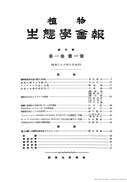Volume 3, Issue 2
Displaying 1-18 of 18 articles from this issue
- |<
- <
- 1
- >
- >|
-
Article type: Cover
1953 Volume 3 Issue 2 Pages Cover1-
Published: November 20, 1953
Released on J-STAGE: August 10, 2017
Download PDF (30K) -
Article type: Cover
1953 Volume 3 Issue 2 Pages Cover2-
Published: November 20, 1953
Released on J-STAGE: August 10, 2017
Download PDF (30K) -
Article type: Appendix
1953 Volume 3 Issue 2 Pages App1-
Published: November 20, 1953
Released on J-STAGE: August 10, 2017
Download PDF (102K) -
Article type: Article
1953 Volume 3 Issue 2 Pages 53-59
Published: November 20, 1953
Released on J-STAGE: August 10, 2017
Download PDF (840K) -
Article type: Article
1953 Volume 3 Issue 2 Pages 60-64
Published: November 20, 1953
Released on J-STAGE: August 10, 2017
Download PDF (523K) -
Article type: Article
1953 Volume 3 Issue 2 Pages 65-72
Published: November 20, 1953
Released on J-STAGE: August 10, 2017
Download PDF (876K) -
Article type: Article
1953 Volume 3 Issue 2 Pages 73-75
Published: November 20, 1953
Released on J-STAGE: August 10, 2017
Download PDF (389K) -
Article type: Article
1953 Volume 3 Issue 2 Pages 76-78
Published: November 20, 1953
Released on J-STAGE: August 10, 2017
Download PDF (389K) -
Article type: Appendix
1953 Volume 3 Issue 2 Pages 79-82
Published: November 20, 1953
Released on J-STAGE: August 10, 2017
Download PDF (375K) -
Article type: Appendix
1953 Volume 3 Issue 2 Pages 83-84
Published: November 20, 1953
Released on J-STAGE: August 10, 2017
Download PDF (143K) -
Article type: Appendix
1953 Volume 3 Issue 2 Pages 85-86
Published: November 20, 1953
Released on J-STAGE: August 10, 2017
Download PDF (190K) -
Article type: Article
1953 Volume 3 Issue 2 Pages 87-
Published: November 20, 1953
Released on J-STAGE: August 10, 2017
Download PDF (219K) -
Article type: Article
1953 Volume 3 Issue 2 Pages 87-
Published: November 20, 1953
Released on J-STAGE: August 10, 2017
Download PDF (219K) -
Article type: Article
1953 Volume 3 Issue 2 Pages 87-88
Published: November 20, 1953
Released on J-STAGE: August 10, 2017
Download PDF (373K) -
Article type: Appendix
1953 Volume 3 Issue 2 Pages 88-
Published: November 20, 1953
Released on J-STAGE: August 10, 2017
Download PDF (107K) -
Article type: Appendix
1953 Volume 3 Issue 2 Pages App2-
Published: November 20, 1953
Released on J-STAGE: August 10, 2017
Download PDF (62K) -
Article type: Cover
1953 Volume 3 Issue 2 Pages Cover3-
Published: November 20, 1953
Released on J-STAGE: August 10, 2017
Download PDF (37K) -
Article type: Cover
1953 Volume 3 Issue 2 Pages Cover4-
Published: November 20, 1953
Released on J-STAGE: August 10, 2017
Download PDF (37K)
- |<
- <
- 1
- >
- >|
